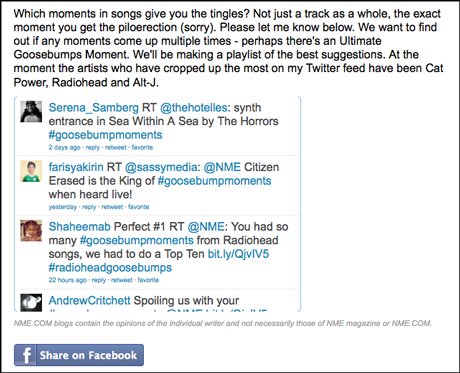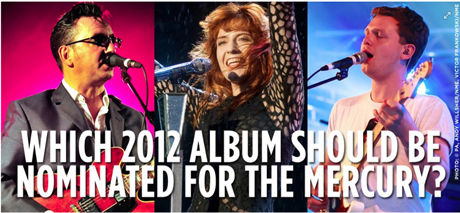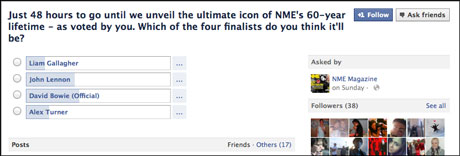
NME has evolved from a print-only publication with a passionate fan-base who waited for the weekly newspaper to arrive through the letterbox or on the newsstand to a multiplatform title with a news site that attracts a mobile, social crowd, keen to join the real-time conversation around the "world's biggest standalone music site".
Helped by NME's 200,000 Facebook fans and 350,000 Twitter followers (which includes notable names such as Lady Gaga, Rhianna, Justin Bieber and Arnold Schwarzenegger), social media drives 30 per cent of NME.com's traffic. And a quarter of NME's audience of 7 million, 2 million of whom are in the UK, accesses the site via mobile.
Indeed Luke Lewis, editor of NME.com, attributes the site's growth over past couple of years to two reasons: the "explosion in social sharing" and "a growth in our mobile user base".
Here we look at seven ways in which NME.com is inviting its audience to influence editorial.
1. Turning comments into a headline
NME.com takes the comments from below the line, from Facebook and from Twitter to create a second story with a headline starting "NME.com users react..."
Passionate fans are not only keen to contribute, but they are also eager to read other fans' reactions. These are often the "best performing" news stories on NME.com, Lewis explained.It's a bit of an ego boost for your users as they like to feel the comment that they left underneath a story is important enough to then be a headline in a separate storyLuke Lewis
Big comeback tracks are a good example of where reader reaction can provide a story. "I remember one that did really well was when Noel Gallagher came back with his first solo single," Lewis said.
"NME.com gets an initial spike from the news story and then uses comments to write a headline such as 'NME.com users hail Noel Gallagher's comeback track as a work of genius'," Lewis explained.
Other examples include "NME.com users react to Reading and Leeds 2012 line-up announcement" and "NME.com users react angrily to 'sickening' comments on Norway tragedy".
"Not only do you get the sustained traffic spike, it's a bit of an ego boost for your users as they like to feel the comment that they left underneath a story is important enough to then be a headline in a separate story."
2. Using Twitter within the news story
NME.com embeds Twitter widgets in some blog posts to encourage and display contributions from their 350,000-strong Twitter community.
For example, last week NME.com asked its users for the points in songs that give them goosebumps. Twitter followers contributed using #GoosebumpMoments and the Twitter widget displayed contributions within the post.

Other examples include #beautifullyrics, #songsthatmakemecry and #songthatchangedmylife, which was a top trending topic globally on Twitter for 24 hours.
"The responses to 'a song that changed my life' were so good that we Storified them and put that in a separate blog post because even though they were just tweet length, we found that they were quite moving and people were really responding in really quite a passionate way."
And with #beatifullyrics, NME.com used ThingLink to make images interactive by adding links to video and other external content. (Find out more about ThingLink here.)
Using the Twitter widget gives NME.com "feedback in real-time and is an instantaneous way of harnessing that feedback", Lewis said. And choosing topics that "absolutely anyone can identify with" whatever their musical taste helps appeal to a wide audience.
3. Using hashtags to crowdsource photos via Twitter
NME turned 60 earlier this year and on the anniversary of the first issue being published, Lewis created a #NME60 hashtag and encouraged users to take pictures of themselves holding up their favourite issue of NME.
"I wasn't sure whether it would really take off but people really responded to it. And the great thing was we had a whole spread of new readers, of teenagers holding up pictures of Arctic Monkeys covers, plus there were people going further back, holding up pictures of The Cure and the Stones and The Beatles.Within two minutes we had created this really rich story that told the whole 60-year story of NME just in pictures and tweetsLuke Lewis
NME turned the hashtagged tweets into a Storify. "Within two minutes we had created this really rich story that told the whole 60-year story of NME just in pictures and tweets," Lewis said.
4. Using Facebook Subscribe
Luke Lewis also uses his personal Facebook account as an "editorial tool". He has set up Facebook Subscribe, allowing Facebook users to follow him and his posts, and enabling Lewis to interact with his 51,000 subscribers.
For example, Lewis has used his personal account to gather suggestions of "beautifully sad songs".
"Facebook is an incredible resource for harvesting editorial ideas from your audience. It's the most valuable tool there is really."Facebook is an incredible resource for harvesting editorial ideas from your audienceLuke Lewis
He added: "When most people think of community and social feedback is just something that sits on the end of the article, beneath the line. I think that's good to turn that on its head and and think of how the feedback could be the headline. We use the feedback we get as a way of planning editorial rather than just something that sits on the end of it."
5. Using Facebook to ask simple questions using photos and polls
Another lesson the NME.com editorial team has learned is to ask simple questions, whether on NME.com, Facebook or Twitter. Speaking in July at news:rewired, Journalism.co.uk's digital journalism conference, Lewis gave the example of asking "what's your favourite Blur song?" (you can see a video of Lewis's presentation here.)
"To me that kind of feedback is as valuable if not more valuable to getting an exclusive interview with a famous band."
Lewis also advises asking questions on Facebook using photos. NME uses Photoshop to add text to a photograph or image to ask a question such as "which 2012 album should be nominated for the Mercury?" or "NME ultimate icon?". Photographs are ranked highly in EdgeRank, Facebook's algorithm, and followers respond well to the visual nature of the requests.

NME.com also uses Facebook polls to allow users to create stories, such as "ultimate icon of NME's 60-year lifetime" as voted by the users.

6. Real-time listening parties
NME.com hosted a "listening party" to mark the 20th anniversary of the release of Nirvana album Nevermind. The editorial team encouraged those listening (at 1pm at 26 September 2011) to use the hashtag #Nevermindlive.
They liveblogged the results, "harnessing the affection and the buzz" for the album.
7. Collaborative Spotify playlists
NME has launched its own app on music listening site Spotify and also uses Spotify as a way of creating collaborative playlists. Here is one readers helped create on "songs that give you goosebumps".
"We can make it an open, collaborative playlist so users can then add further tracks to it if they want," Lewis explained.
And by using the frictionless sharing Spotify app within Facebook, Lewis lets his subscribers see what Lewis is listening to. "I'm sharing my music recommendations without even writing a single word," he said.
To find out how NME uses Tumblr, see this feature.
Free daily newsletter
If you like our news and feature articles, you can sign up to receive our free daily (Mon-Fri) email newsletter (mobile friendly).
Related articles
- Brian Whelan from Times Radio on growing a successful YouTube news channel
- How journalists can decode 'algospeak' on social media
- Rachel Duffy, senior social media editor of The Telegraph, on using Reddit for news
- 10 creative ways to interview celebrities and experts
- LinkedIn newsletters: are they what they are cracked up to be?









